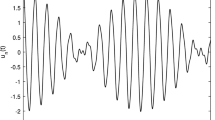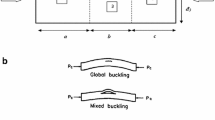Abstract
Localized buckling modes in the axially compressed strut on a distributed-spring elastic foundation with a softening quadratic nonlinearity are numerically calculated based on a modified Petviashvili method in the spatial frequency domain. As the load decreases (increases), the maximum displacement of the corresponding localized buckling mode increases (decreases) and its width decreases (increases). Then, under the influence of longitudinal and transverse perturbations, stabilities of these localized buckling modes are numerically investigated. The adopted numerical method is the spatial Fourier transform in space and the finite difference method in time. For initial positive longitudinal perturbations, localized buckling modes are unstable showing focusing-type finite-time blowup singularities. For initial negative perturbations, localized buckling modes are unstable and become dispersed showing small-amplitude oscillations. For initial transverse perturbations, localized buckling modes are unstable and are transformed into three-dimensional locally confined modes, finally showing finite-time blowup singularities.












Similar content being viewed by others
References
Champneys AR, Hunt GW, Thompson JMT (1997) Localization and solitary waves in solid mechanics. Philos Trans R Soc Lond A 355:2077–2081
Lord GJ, Champneys AR, Hunt GW (1997) Computation of localized post buckling in long-axially compressed cylindrical shells. Philos Trans R Soc Lond A 355:2137–2150
Hunt GW, Lord GJ, Champneys AR (1999) Homoclinic and heteroclinic orbits underlying the post-buckling of axially-compressed cylindrical shells. Comput Methods Appl Mech Eng 170:239–251
Hunt GW, Peletier MA, Champneys AR, Woods PD, Wadee MA, Budd CJ, Lord GJ (2000) Cellular buckling in long structures. Nonlinear Dyn 21:3–29
Goriely A, Tabor M (1997) Nonlinear dynamics of filaments III—instabilities of helical rods. Proc R Soc A 453:2583–2601
Thompson JMT, Champneys AR (1996) From the helix to localized writhing in the torsional post buckling of elastic rods. Proc R Soc A 452:117–138
Van der Heijden GHM, Champneys AR, Thompson JMT (2002) Spatially complex localization in twisted elastic rods constrained to a cylinder. Int J Solids Struct 39:1863–1883
Hunt GW, Wadee MA (1998) Localization and mode interaction in sandwich structures. Proc R Soc A 454:1197–1216
Brau F, Damman P, Diamant H, Witten TA (2013) Wrinkle to fold transition: influence of the substrate response. Soft Matter 9:8177–8186
Pocivavsek L, Dellsy R, An Kern, Johnson S, Lin B, Lee KYC, Cerda E (2008) Stress and fold localization in thin elastic membranes. Science 320:912–916
Audoly B (2011) Localized buckling of a floating elastica. Phys Rev E 84:011605
Buffoni B, Champneys AR, Toland JF (1996) Bifurcation and coalescence of a plethora of homoclinic orbits for a Hamiltonian system. J Dyn Differ Equ 8(2):221–279
Calvo DC, Yang T-S, Akylas TR (2000) On the stability of solitary waves with decaying oscillatory tails. Proc R Soc Lond A 456:469–487
Hunt GW, Bolt HM, Thompson JMT (1989) Structural localization phenomena and the dynamical phase-space analogy. Proc R Soc Lond A 425(1869):245–267
Hunt G (2006) Buckling in space and time. Nonlinear Dyn 43:29–46
Sandstede B (1997) Instability of localized buckling modes in a one-dimensional strut model. Philos Trans R Soc Lond A 355:2083–2097
Wadee MK, Hunt GW, Whiting AIM (1997) Asymptotic and Rayleigh-Ritz routes to localized buckling solutions in an elastic instability problem. Proc R Soc Lond A 453:2085–2107
Wadee MK, Bassom AP (1999) Effects of exponentially small terms in the perturbation approach to localized buckling. Proc R Soc Lond A 455:2351–2370
Wadee MK, Bassom AP (2000) Characterization of limiting homoclinic behavior in a one-dimensional elastic buckling model. J Mech Phys Solids 48:2297–2313
Wadee MK, Coman CD, Bassom AP (2002) Solitary wave interaction phenomena in a strut buckling model incorporating restabilisation. Physica D 163:26–48
Wadee MK, Coman CD, Bassom AP (2004) Numerical stability criteria for localized post-buckling solutions in a strut-on-fondation model. J Appl Mech 71(3):334–341
Cho Y (2015) A modified Petviashvili method using simple stabilizing factors to compute solitary waves. J Eng Math 91:37–57
Cho Y (2018) Stability of gravity-capillary solitary waves on shallow water based on the fifth-order Kadomtsev-Petviashvili equation. Phys Rev E 98:012213
Nohara BT, Arimoto A (2007) On the quantic nonlinear Schrödinger equation created by the vibration of a square plate on a weakly nonlinear elastic foundation and the stability of the uniform solution. Jpn J Ind Appl Math 24:161–179
Zarubinskaya MA, Van Horssen WT (2005) On the vibration of a simply supported square plate on a weakly nonlinear elastic foundation. Nonlinear Dyn 40:35–60
Wadee MK, Lloyd DJB, Bassom AP (2016) On the interaction of uni-directional and bi-directional buckling of a plate supported by an elastic foundation. Proc R Soc A 472:20150873
MeKenna PJ, Walter W (1990) Traveling waves in a suspension bridge. SIAM J Appl Math 50:702–715
Chen W, Gui W, Yang L, Zhu H, Tang Z (2019) Wrinkling of two-dimensional materials: methods, properties and applications. Nanoscale Horiz 4:291–320
Budday S, Steiman P, Kuhl E (2015) Secondary instabilities modulate cortical complexity in the mammalian brain. Philos Mag 95:3244–3256
Acknowledgements
This work was supported by National Research Foundation of Korea (NRF) (NRF-2017R1D1A1B03028299).
Author information
Authors and Affiliations
Corresponding author
Additional information
Publisher's Note
Springer Nature remains neutral with regard to jurisdictional claims in published maps and institutional affiliations.
Appendix
Appendix
The nonlinear algebraic equation to be solved is Eq. (17).
Here, the convolution terms can be re-expressed using a matrix-vector multiplication. In this case, for the column vector \({\hat{\eta }}=(c_0, c_1, c_2, \ldots ,c_{n-1})^\mathrm{T}\) (where T means the transpose), the circular convolution term for this finite-length vector is equal to
In addition, \(D=(d_0, d_1, d_2, \ldots ,d_{n-1})^\mathrm{T}\) in Eq. (A.1) can be expressed as a diagonal matrix, then, the original equation, Eq. (A.1) becomes the following nonlinear matrix problem:
For a symmetric buckling mode solution, the matrix \({\mathbf {C}} ({\hat{u}})\) is a symmetric circulant Toeplitz matrix, and \({\mathbf {D}}\) is a symmetric diagonal matrix. Therefore, the resultant matrix \({\mathbf {A}}\) in Eq. (A.3) is diagonalizable. Like in the linear matrix eigenvalue problem, if the diagonalizable square matrix \({\mathbf {A}}\) with a size \(n \times n\) has a dominant eigenvalue with a corresponding dominant eigenvector, then one can choose an initial approximation of a nonzero vector \({\hat{\mathbf {u}}}_{\mathbf {0}}\) with a size \(n \times 1\) to perform the following numerical sequence with a proper stabilizing factor, assuming the sequence to be convergent. In other words,
Since all the matrices in Eq. (A.3) are diagonalizable, one can assume that the matrix \(\mathbf {A_i}\) (\(i=0,1,2,3, \ldots ,k\) ) has a set of eigenvectors \(\{ {\mathbf {x_0^{(i)}, x_1^{(i)}, \ldots , x_{n-1}^{(i)}}} \}\) and a set of associated eigenvalues \(\{ {\lambda _0^{(i)},\lambda _1^{(i)}, \ldots , \lambda _{n-1}^{(i)}} \}\) with descending orders of their absolute magnitudes \(\big ( {\big | {\lambda _0^{(i)}} \big | > \big | {\lambda _1^{(i)}} \big |} \ge \cdots \ge \big | {\lambda _{n-1}^{(i)}} \big | \big )\) at each iteration step. To begin with, the initial vector \({\hat{\mathbf {u}}}_{\mathbf {0}}\) can be expressed as a linear combination of the eigenvectors of \(\mathbf {A_0}\) as follows:
Here, \(c_j^{(0)}~(j=0,1, \ldots , n-1)\) are coefficients in the linear combination. In the first iterative step, \({\hat{\mathbf {u}}}_{\mathbf {1}}\) in Eq. (A.4) can be expressed using Eq. (A.5) as follows:
In the second iterative step,
Since \({\mathbf {x}}_j^{(0)}~(j=0,1, \ldots ,n-1)\) can be expressed as a linear combination of \({\mathbf {x}}_j^{(1)}~(j=0,1, \ldots ,n-1)\), say,
Then, by substituting Eq. (A.8) into Eq. (A.7),
Similarly, in the third iterative step,
Deductively, in the kth iterative step,
Depending on the relative magnitude ratio, \(\left| {\lambda _1^{(i)}\big /\lambda _0^{(i)}} \right| <1\), which affects the convergence rate, the above sequence is expected to converge to an intermediate state where the sets of eigenvector and eigenvalue become almost constant. Including and after the jth step, let’s assume that the sets of eigenvectors and eigenvalues become almost equal to \(\mathbf {\{ {x_0, x_1, x_2, \ldots , x_{n-1}} \}}\) and \(\{ {\lambda _0, \lambda _1, \lambda _2, \ldots , \lambda _{n-1}} \}\), where \(( \left| {\lambda _0} \right| > \left| {\lambda _1} \right| \ge \cdots \ge \left| {\lambda _{n-1}} \right| ) \), respectively. Based on these eigenvectors, Eq. (A.11) is re-expressed as
For the next m sequences, assuming \(\mathbf {A_k \approx A_{k+1} \approx \cdots \approx A_{k+m}}\)
From Eq. (A.13), \({\hat{\mathbf {u}}}_{\mathbf {k+m}} \approx (\lambda _0)^m c_0 \mathbf {x_0}\) as m approaches infinity (practically, some finite numbers) due to the existence of the dominant eigenvalue \(\lambda _0~( \left| {\lambda _0} \right| > \left| {\lambda _1} \right| \ge \cdots \ge \left| {\lambda _{n-1}} \right| ) \). In other words, the final nonlinear solitary wave solution in the physical domain is equal to a multiple of the inverse Fourier transform of the dominant eigenvector \(\mathbf {x_0}\) in the wavenumber domain.
Rights and permissions
About this article
Cite this article
Kang, Y.J., Cho, Y. Numerical study on the instability of localized buckling modes in the axially compressed strut on a distributed-spring elastic foundation with softening quadratic nonlinearity. J Eng Math 122, 117–137 (2020). https://doi.org/10.1007/s10665-020-10051-w
Received:
Accepted:
Published:
Issue Date:
DOI: https://doi.org/10.1007/s10665-020-10051-w




